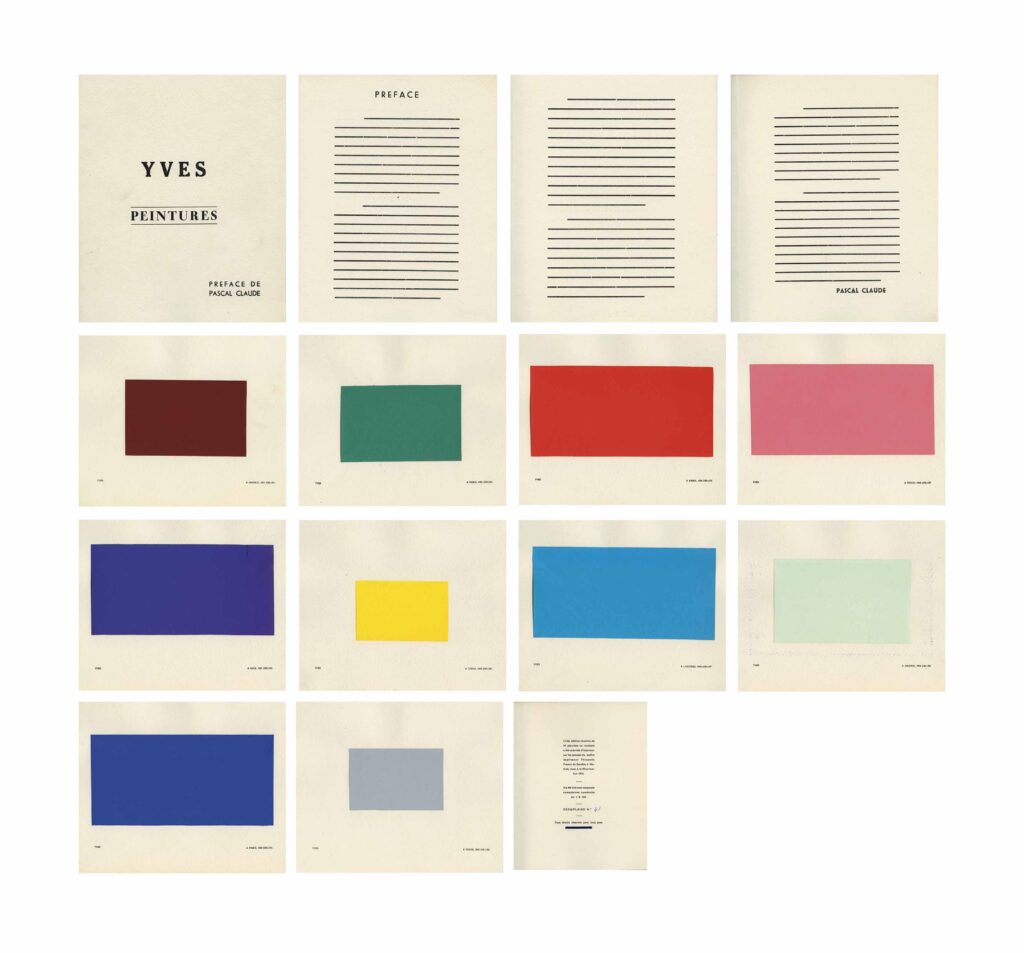
All thinking about early, tiny Yves Klein paintings inevitably turns to the most and smallest of them all—if they existed—Yves Peintures.
While poking around to write another blog post about Yves Peintures, which the Estate calls the “first gesture” of Klein’s public career as an artist, I find I am more confounded and confused than ever about what the project/object actually is, what it was, and what it became.
At the most basic level, Yves Peintures is a portfolio, sometimes called an artist book, Klein made in late 1954 in Spain, that echoes the form of a Parisian exhibition catalogue. Rectangles of colored paper mounted on sheets printed with captions seemingly illustrate ten monochrome paintings of various colors, dates, sizes, and cities of creation. All are attributed to Yves. Some “paintings” have “Yves” printed in cursive on the lower right corner, as if they are signed.
The colophon says Yves Peinture was published in a numbered edition of 150, but how many copies were actually made—and when—and how many exist now, are all unclear. Let’s come back to that.
The point, or at least the effect, of this book seems to be provocation, hype, and deception, a tool he could use to hustle his way into an avant-garde art career in Paris. Because at first glance, it looked like Klein—who’d had no shows and made no known art up to that point, least of all any monochromes—had exhibited large, monochrome paintings made over several years, in cities all over the world. There’s at least one anecdote Klein told of whipping out a fresh copy of Yves Peintures in a Paris bar to win an argument with some belligerent abstract painters, like a monochrome mic drop. Coupled with stories of exhibiting monochromes maaany times. in his apartment. to his roommates, Yves Peintures seems like another bit of [self-generated] evidence to backdate Klein’s claim of ownership of the monochrome, or at least to retcon the development of his artistic ideas.
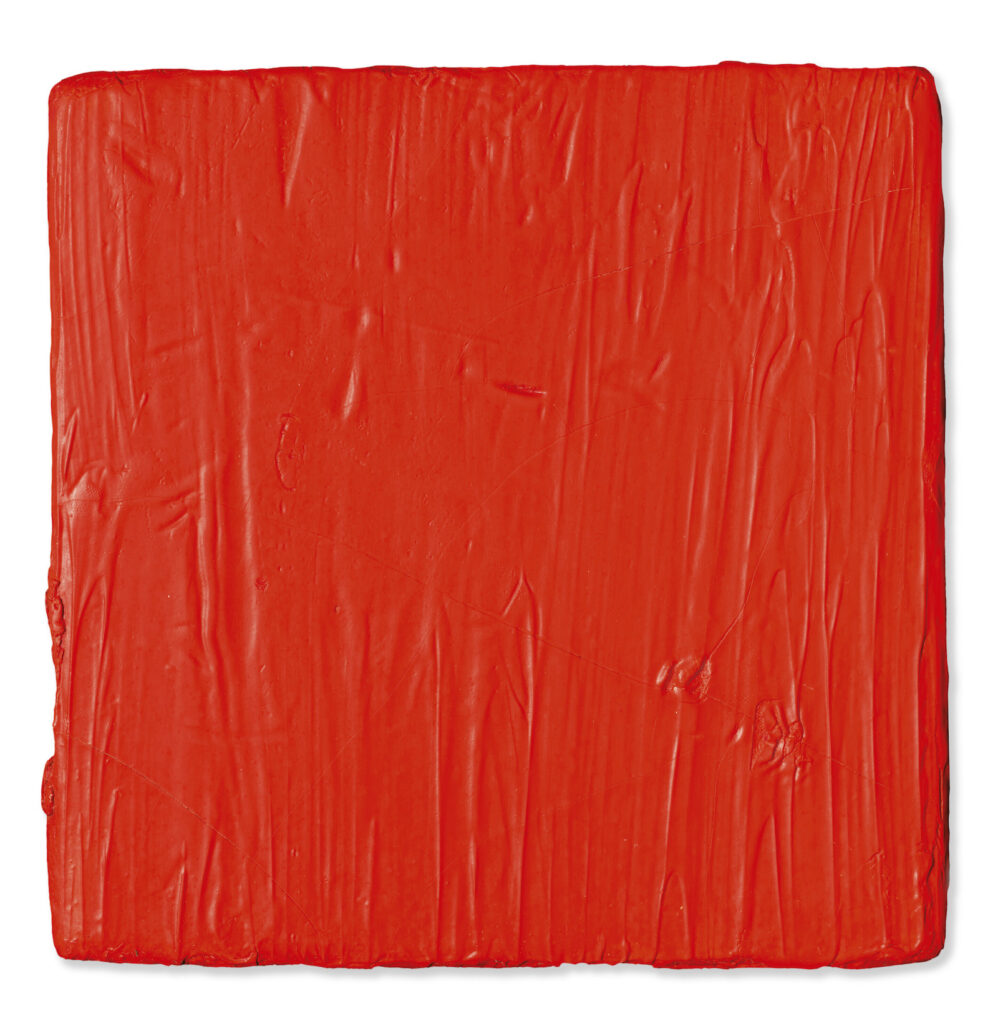
Which kind of worked? Within a few months, in 1955, Klein did start painting monochromes—in Yves Peintures-scale—and his brandishing of his publication did help, he said, get him a show. But it’s not clear how well-known Yves Peintures ever actually was; whatever impact it had was certainly outstripped by every thing Klein épatéed the bourgeoisie with after it.
It was only in 1976, thought, when Nan Rosenthal [Piene] published her dissertation on Klein, that Yves Peintures began to be interpreted as something other than a dishonest scam. Rosenthal helped reconsider the book as an art object itself, noting that the dimensions in the captions correspond to the plates, in millimeters, not to a [non-existent] painting, in centimeters. Thus is Yves Peintures an actual exhibition of real, but tiny, works, a forward-looking reworking of Duchamp’s Boîte-en-valise. In a big 1982 retrospective for which Rosenthal wrote a text, Yves Peintures was presented as the OG proposte monocrome, a radical blueprint for Klein’s whole future.

In his 2005 review of the Klein retrospective in Frankfurt, Yve Alain Bois said Yves Peintures “one of the first post-Duchampian acts of postwar Europe,” could have been presented more powerfully if the curators had also included “its twin,” Haguenault Peintures, an identical book of imaginary monochromes, only reattributed to an imaginary artist. Which, what? And if that weren’t enough “to undermine all claims of authenticity, several of the plates are labeled with identical dimensions, even though they differ obviously in proportion.” Bookmark the Haguenault thing.
And step forward to 2007, when Bois’ text for the Pompidou’s Klein retrospective comes out. He’s talked with Rosenthal, who has seen some stuff, including several copies of Yves Peintures exhibited in various places, including Frankfurt, which she compared with the copy Klein sent to his mother. To Rosenthal the mismatched dimensions in some Yves Peintures indicated the copy was “posthumous and incorrect.” She concluded that someone with access had assembled copies of Yves Peintures out of loose materials in the artist’s archive. When considering her own long, early engagement with the archive, and her critiques of the Klein Estate’s handling of a 1995 retrospective, it definitely sounds like Rosenthal, if she wasn’t ready to call shenanigans outright, had reasons to believe the artist’s corpus was still warm and expanding long after his body had died.
I can only find a single copy of Haguenault Peintures in the wild, at a 2011 rare book auction in Paris [above], where its estimate was less than a tenth of its twin. While the oft-noted difference between the two versions—the inclusion of collector names in Haguenault—is mentioned, it also seems weird that six of the 10 monochrome plates have the “Yves” signature in the corner. [I just found a copy of the Drouot pic of Haguenault on my computer from 2017, but I do not remember looking for it then, much less finding it. Wild.]
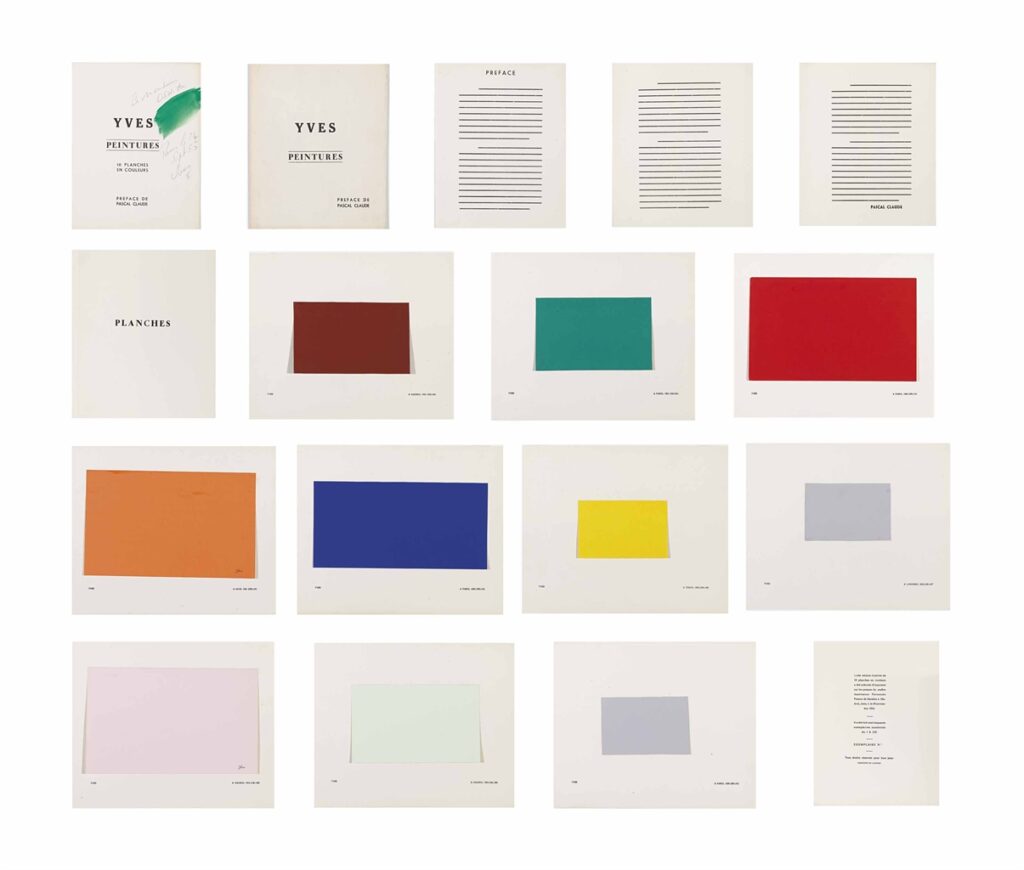
Yves Peintures, though, has turned up at auction more frequently. One’s for sale this month, in fact, from the collection of daughter/art dealer Marie-Puck Broodthaers. [update: it sold for EUR48,423, no scam there.]
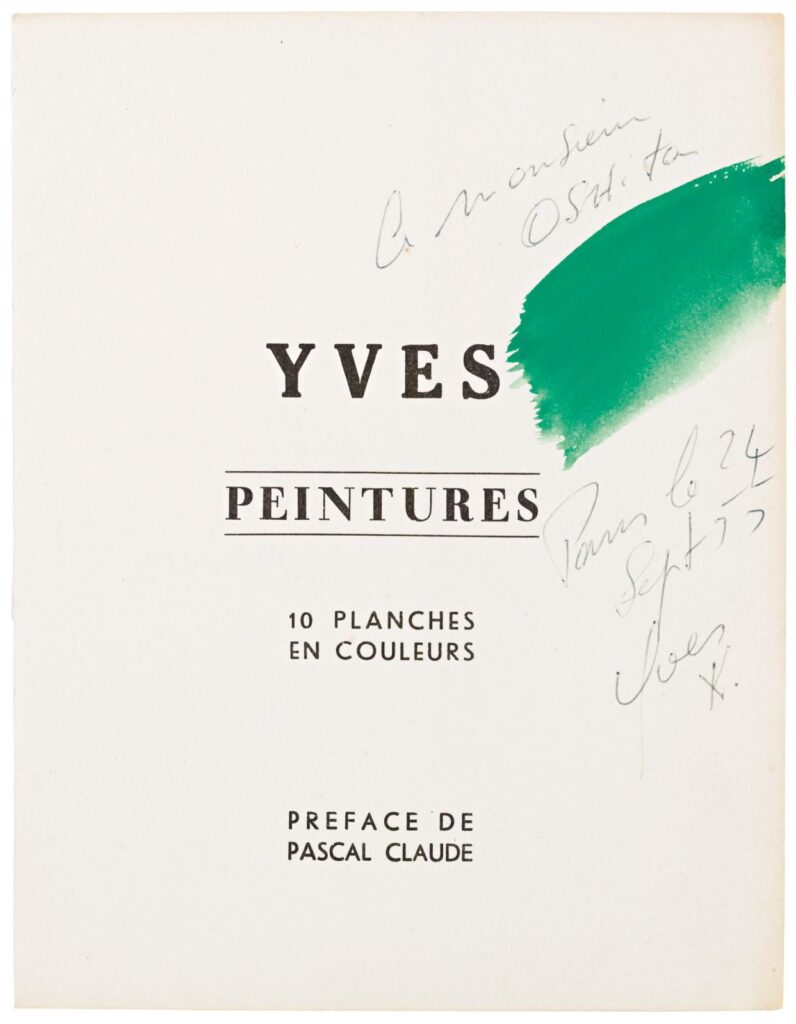
Another example, sold in December 2014, six months after Nan Rosenthal’s death. The cover includes a green diagonal brushstroke, and a dedication from the artist, “a Monsieur Oshita,” dated 24 Sept. 1955. Not only are two of the monochromes nearly identical, several of the plates do not match the dimensions printed below them. Another example had a blue stroke in its dedication. According to the description, there was another dedication inside with a yellow stroke, and the dimensions for each plate/painting was annotated by hand.
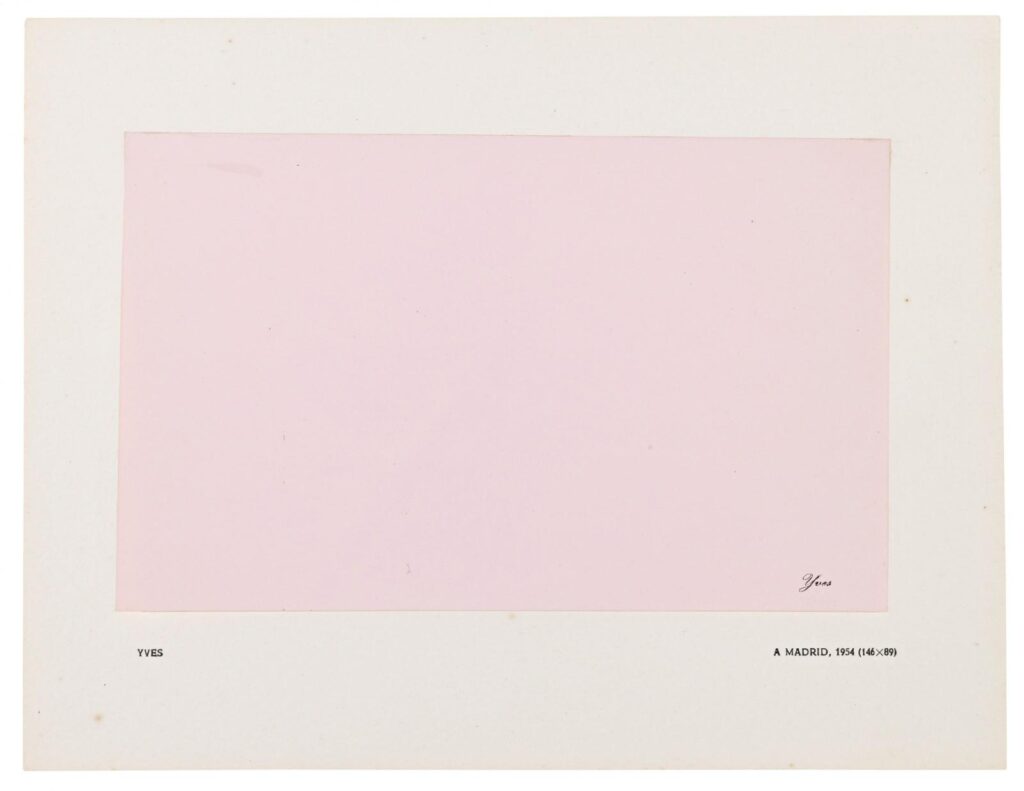
Whatever Nan Rosenthal saw that led to her reinterpretation of Yves Peintures, and whatever made her skeptical of the basic material facts of Klein’s work, I would believe her. A part of me wants to say, well, the Yves Klein Archives would publish mismatched Yves Peintures as canon; they made them! But it seems more likely, or at least as likely, that Klein’s aunt did not care to pay for an entire 150-copy print run of her nephew’s made-up catalogue. And even if she had, a frenetic, ambitious Klein did not care to sit and assemble 1500 precisely cut and hand-tipped plates into their artfully mixed groupings. But whenever someone came to the studio who he wanted to impress, he graciously pulled a portfolio together and painted and signed it with a monochrome flourish.
Previously, related: Yves Klein, proposte minichrome
2013: Hito, Alexander, October, Yves Peintures
